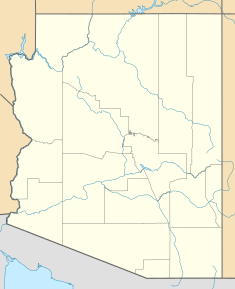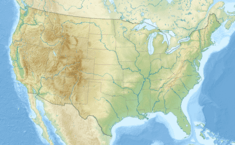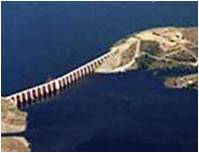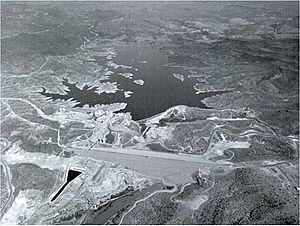New Waddell Dam facts for kids
Quick facts for kids New Waddell Dam |
|
|---|---|
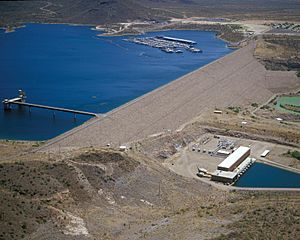 |
|
|
Location of New Waddell Dam in Arizona#USA
|
|
| Country | United States |
| Location | Maricopa County, Arizona |
| Coordinates | 33°50′49″N 112°15′58″W / 33.84694°N 112.26611°W |
| Purpose | Irrigation, power |
| Status | Operational |
| Construction began | 1985 |
| Opening date | 1994 |
| Construction cost | $625 million |
| Owner(s) | U.S. Bureau of Reclamation |
| Dam and spillways | |
| Type of dam | Embankment, zoned earth-fill |
| Impounds | Agua Fria River |
| Height (foundation) | 440 ft (130 m) |
| Height (thalweg) | 300 ft (91 m) |
| Length | 4,700 ft (1,400 m) |
| Width (crest) | 35 ft (11 m) |
| Width (base) | 1,514 ft (461 m) |
| Dam volume | 16,200,000 cu yd (12,400,000 m3) |
| Spillways | 2 |
| Spillway type | Un-gated, free-flow, fuseplug embankment |
| Spillway capacity | 316,000 cu ft/s (8,900 m3/s) (combined; at elevation) |
| Reservoir | |
| Creates | Lake Pleasant |
| Total capacity | 1,108,600 acre⋅ft (1.3674×109 m3) |
| Catchment area | 1,459 sq mi (3,780 km2) |
| Surface area | 12,040 acres (4,870 ha) |
| Normal elevation | 1,725 ft (526 m) (maximum) |
| Power station | |
| Commission date | 1994 |
| Turbines | 4 x 11.25 MW (15,090 hp)pump-generators |
| Installed capacity | 45 MW (60,000 hp) |
The New Waddell Dam is a large embankment dam built on the Agua Fria River in Maricopa County, Arizona, about 35 miles (56 km) northwest of Phoenix. It's a key part of the Central Arizona Project (CAP), which brings water to many parts of Arizona. The dam also helps the Maricopa Water District get water for farms.
This dam creates Lake Pleasant. This lake gets water from the Agua Fria River and the CAP aqueduct. The dam also helps prevent floods, makes electricity using water power, and offers fun activities like boating and fishing. Building the dam started in 1985 and finished in 1994. Its reservoir covered an older dam called the Old Waddell Dam, which was built in 1927.
Contents
History of the Dam
The Old Waddell Dam
The first idea for a dam here was called the Frogs Tank Dam. Local business people wanted to use the Agua Fria River to water about 100,000 acres (40,000 ha) of land. They planned to build a storage dam, a diversion dam, and a system of canals. In 1888, they formed the Agua Fria Water and Land Company to start this project.
Construction began in 1892. However, in 1896, the project stopped because there wasn't enough money due to a bad economy across the country. The company went bankrupt, but William Beardsley kept the dream alive. Only the foundation of the main storage dam was built, along with some work on the diversion dam and canals.
After almost 30 years of trying to find money, William Beardsley hired engineer Carl Pleasant. They decided to use a new, cheaper, and somewhat debated design for the main dam: a multiple-arch buttress dam. In 1925, Beardsley created the Beardsley-Agua Fria Water Conservation District to raise money.
Construction officially began in 1926. The dam was renamed Pleasant Dam that same year. By October 1927, the dam was finished. It cost over $3.3 million and employed up to 600 workers. Before it opened, some cracks were found, which caused worries about its safety. This delayed its opening until February 1928.
To make sure the dam was safe, officials ordered the spillway to be lowered by 24 feet (7.3 m). This would prevent too much water from building up and putting stress on the dam. They also set rules for how high the water in the reservoir could be. The dam was repaired until 1935. In the early 1960s, it was renamed the Waddell Dam.
Building the New Waddell Dam
In 1973, work began on the Central Arizona Project (CAP), a huge system to bring water to Arizona. One important part of this project was a new storage dam. In 1977, the US President suggested removing some planned dams from the CAP because they were too expensive or caused too many problems.
After much discussion, in 1983, officials agreed on a new plan called Plan 6. This plan included rebuilding the Stewart Mountain Dam, making the Roosevelt Dam bigger, and building the New Waddell Dam on the Agua Fria River. This plan was approved in 1984.
Construction on the New Waddell Dam started in 1985. Workers dug out its foundation and built tunnels to move water. By the end of 1992, parts of the Old Waddell Dam were carefully broken. This allowed the new reservoir to fill up behind the New Waddell Dam, which was already mostly built.
By 1994, the reservoir was full, making the lake almost three times bigger than the old one. In the same year, the dam's pump-generating plant started working. The New Waddell Dam cost more than $625 million to build.
Dam Design and How It Works
The New Waddell Dam is an earth-fill dam, meaning it's made mostly of compacted earth and rock. It stands 300 feet (91 m) tall from the riverbed and 440 feet (130 m) from its deepest foundation. The dam is very long, stretching 4,700 feet (1,400 m) across. It contains a massive 16.2 million cubic yards (12.4 million m³) of material.
The lake created by the dam, Lake Pleasant, can hold a huge amount of water. When full, its surface covers 12,040 acres (4,870 ha).
About 1.25 miles (2.01 km) northwest of the dam are two spillways. Spillways are like safety valves that release extra water when the lake gets too full. One is a long, open spillway, and the other is a special "fuse plug" embankment. These spillways can release a lot of water quickly if needed.
Water from Lake Pleasant can be released through the dam's outlet or its power plant. This water then flows into canals like the Waddell Canal or the Beardsley Canal. These canals carry water to farms and other areas. The Beardsley Canal can also connect with the CAP aqueduct to get more water.
The New Waddell Dam helps the CAP deliver more water to Arizona. Water in Lake Pleasant is shared between the CAP and the Maricopa Water District. The dam also has a special "pump-generating plant." In winter, when electricity is cheaper, extra water from the CAP aqueduct is pumped uphill into Lake Pleasant for storage. In summer, when electricity is more expensive, this stored water is released back downhill through generators to make hydroelectric power. Selling this electricity helps pay for the dam's cost. The plant has four pump-generators and can produce 45 megawatts of power.
Recreation at Lake Pleasant
Lake Pleasant, formed by the dam, is a popular spot for fun activities for both locals and tourists. The lake has a marina for boats. Around the lake, you'll find over 450 picnic spots and 225 camping sites. There are also several miles of trails for hiking and exploring. Because the lake's water level changes throughout the year, these areas are designed to be easy to reach no matter how high or low the water is.
Environmental Impact
Before the New Waddell Dam was built, studies were done to see how it would affect the fish in the area. A study finished in 2005 found that the larger lake has fewer nutrients because of the CAP water added to it. Also, the changing water levels have reduced places for fish to hide, which might affect their food and where they lay eggs.
The number of largemouth bass has gone down. However, striped bass have entered the lake, likely from eggs carried in the CAP water. Around the lake, the Bureau of Reclamation has worked to protect habitats for wildlife, including bald eagles and Gila topminnows.
- Historic American Engineering Record (HAER) No. AZ-11, "Waddell Dam, On Agua Fria River, 35 miles northwest of Phoenix, Phoenix vicinity, Maricopa County, AZ" (Old Waddell Dam)


